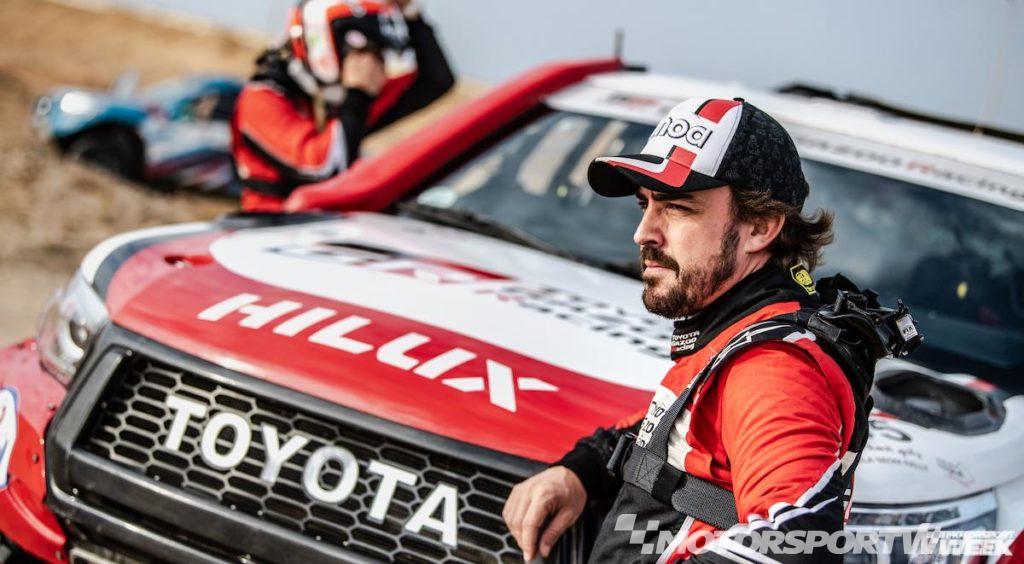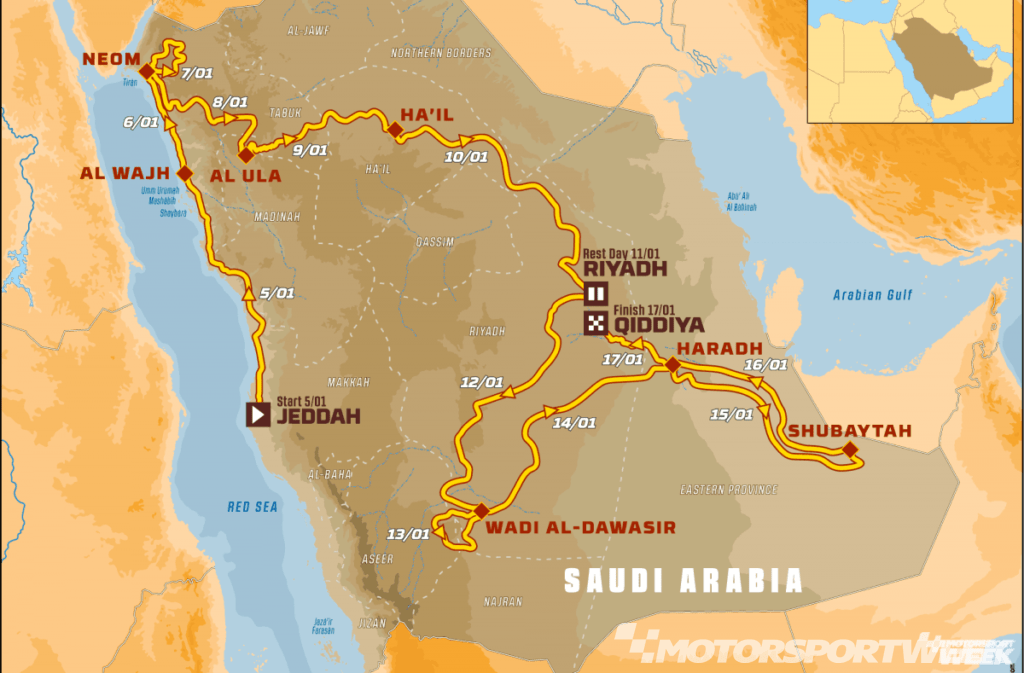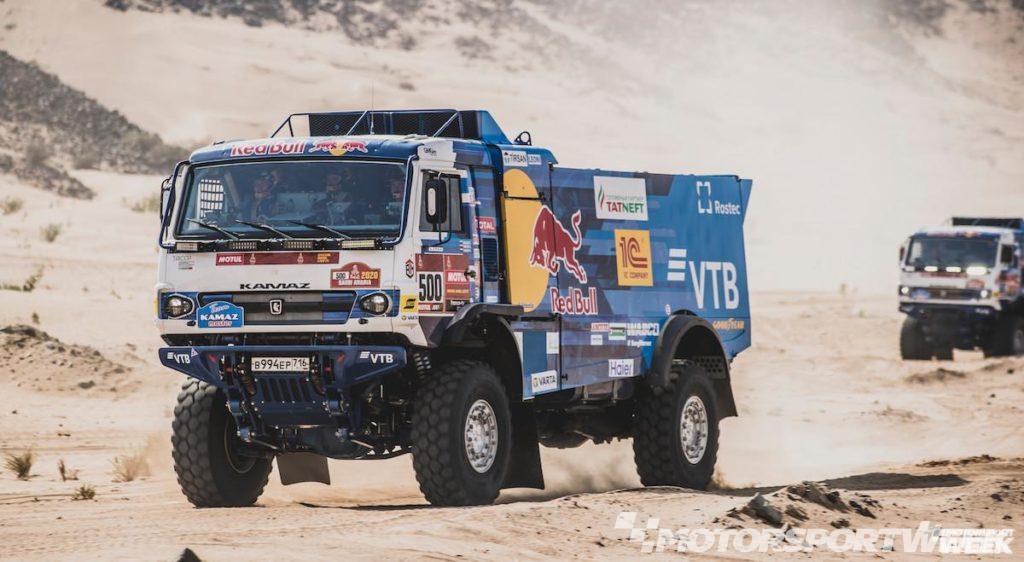No January is complete without motorsport’s most challenging event: the Dakar Rally. This year’s edition marks the third instalment in the Dakar Rally’s illustrious history: having moved from North Africa to South America in past years, the event now moves to Saudia Arabia for 2020. Mapped through a new country, the organisers have tightened the rules and made this route even tougher.
A total of 557 competitors will take up the start line for Stage One on Sunday, over a route snaking through dunes reaching 250-metres in height for a total stage distance of 752km (of which 319km is the Special Stage), and Monday will see a further 401km contested.
Navigation – as ever – is vital for stage wins on this event, and organisers have upped the ante with stricter controls all while levelling the playing field too. New colour-coded roadbooks will be distributed before the start of at least four stages of this year’s event, meaning that all teams will be on an equal footing in terms of preparation. Racing from Jeddah to Qiddiya (near Saudi Arabia’s capital Riyadh) over 12 days and some 7,500km in total (with 5,000km of Special Stages), 75 per cent of this year’s route will be contested over sandy roads with one much-needed rest day in the middle. Valleys, mountains, canyons, and sand dunes: there will be no let-up for competitors, but that’s the global appeal of this event.

Taking the headlines in the run-up to the start has undoubtedly been Fernando Alonso’s entry with Toyota Gazoo Racing (in a Toyota Hilux). Partnered with five-time Bike category winner Marc Coma, Alonso has undergone a rigorous development, training and testing programme to acclimatise to off-road cross country racing. He is the first Formula 1 champion to participate, but not the first F1 driver to win this event; that honour belongs to Belgium’s Jacky Ickx who claimed victory in 1983. The Spaniard has adjusted quickly to off-road racing and his talents behind a car’s steering wheel are undoubted. Will that skill translate to stage wins?
His team-mate, Qatari Nasser Al-Attiyah, is reigning Dakar champion with the Toyota Gazoo Racing squad, and is favoured for the victory this year again. He will be aiming to set the pace, with plenty of experience and knowledge from rally and cross-country events past.
Bahrain JCW X-Raid Team’s Stephane Peterhansel (MINI Cooper Works Buggy) poses the strongest opposition to Al-Attiyah. After a dismal event in 2019 that saw him retire from the rally, the MINI Buggy has been re-worked and is set to give the Hiluxs a tougher time on the dunes. Peterhansel is crafty and will most certainly use his competitive experience in attempts to outwit and outpace Al-Attiyah.

Two-times winner and Peterhansel’s team-mate, WRC ace Carlos Sainz, is vastly experienced and a wily 12-time Dakar Rally competitor with two victories thus far to his name. The Spaniard, El Matador to his fans, is fast and fearless in his pursuit for stage victories and the 2020 MINI Buggy suits his driving style more this year. Will 57-year-old El Matador be able to lift the trophy once more against his younger rivals?
Runner-up in 2019, Nani Roma is no stranger to the Dakar Rally’s demands: he’s now competed on three continents throughout this event’s past, with his first participation in 1996 in the Bikes category. This year he competes for the Borgward Rally Team in their Borgward BX7 Evo. To underestimate him is a mistake. The Spaniard is focused on victory this year.
Toyota Gazoo Racing’s Giniel de Villiers has finished all 16 Dakar Rally’s he’s entered and with one victory to his name – a record of driving skill that’s not to be discounted. The South African and his Hilux suffered a disappointing event in 2019, but this combination might prove difficult to outpace in the second half of this year’s event where he consistently ratchets up his speed while others slow their pace to reach the finish…

The dark horse for 2020’s top spot is Yazeed Al Rajhi. Competing on tracks and deserts he knows like the back of his hand, Al Rajhi will most likely be a regular stage podium finisher. With the Saudi nation behind him every kilometre of the way, and the mighty Toyota Hilux underneath him from Overdrive Toyota, his sixth participation in the Dakar Rally might just bring him the winner’s trophy. His pace over this terrain is undoubted: in the run-up to the Dakar, he claimed victory in the Rally Qassim and the Al Alu-Neom Rally that were contested over the very same dunes and sand tracks as this year’s Dakar.
In the Trucks Category, a strong field of 47 crews will do battle. These giants of the desert mesmerise with their jumps, speed and ruggedness, with all eyes on the dominant Kamaz-Master outfit. As with the Cars and Bikes category, manufacturer rivalry makes for an interesting race. Here Renault Trucks, Tatra, Kamaz and Hino will fight it out in the dunes for 2020, with reigning champion Eduard Nikolaev (Kamaz-Master) the driver to outpace. The Russian is a worthy successor to the multiple winner and Dakar legend Vladimir Chagin, and he aims to show that once more in 2020.
With 75 per cent of the route staged on dunes and sand roads, the Trucks face their toughest route ever in 2020. That’s why Ales Loprais (Instaforex Loprais Team) and his Tatra truck are rumoured to be in with a strong shout for victory. Without a win to his name in the Dakar, the Czech won’t be holding back in his bid for stage wins and topping the leaderboard come Friday 17 January. The rivalry between Loprais and Nikolaev is intense.

On two wheels, a handful of riders are all capable of winning this year’s event. However, 2019’s winner Toby Price and his RedBull KTM Factory team-mates are aiming for a full sweep of the podium to secure another record for their KTM team. This Australian rider will be hoping for an injury-free run in 2020, as he has completed the past two Dakars with broken bones. How much faster will he be than his compatriots and rivals? Team-mates Sam Sunderland (Great Britain) and Matthais Walkner (Austria) will do their utmost to keep Monster Energy Honda Team 2020’s Kevin Benavides (Argentina) and Rockstar Energy Husqvarna Factory Racing’s Pablo Quintanilla (Chile) behind them on the leaderboard. That in itself will be another fascinating story to follow in 2020.
Beginning on Sunday 5 January in Jeddah, the rally will end on Friday 17 January in Qiddiya. Join us for daily insights and reports from motorsport’s dustiest event in 2020.
The Route
Stage 1 – January 5
The 2020 Dakar starts off in Jeddah, covering a total of 752km, with the competitors finishing the day in Al Wajh. Special stages, from which overall classifications are created, make up 319km of the opening day’s racing.
Stage 2 – January 6
The racing continues on from Al Wajh to Neom, with competitors enjoying a shorter day at 401km overall. Those expecting the racing to be any less furious will be in for a shock, however, as special stages account for a full 367km of the route.
Stage 3 – January 7
Stage three will see competitors start and finish the day in Neom, but they’ll still be covering a challenging 489km overall, with 404km marked as special.
Stage 4 – January 8
Leaving Neom, the race heads to Al-`Ula, some 676km away. It’s another challenging day when it comes to the overall classification, with a huge 453km marked as special.
Stage 5 – January 9
Stage five sees competitors race between Al-`Ula and Ha’il, covering a total distance of 563km. 353km of that is special, giving racers a slightly easier – or at least shorter – day when it comes to overall timings.
Stage 6 – January 10
The race then continues to Riyadh in one of the longest stages of the 2020 Dakar, with over 478km marked as special and a huge 830km travelled in total.
Rest day – January 11
After such a monster stage, competitors and teams alike will be glad of the rest day, with the rally staying in Riyadh for some much-needed repair and recovery.
Stage 7 – January 12
Stage 7 sees the teams back on the road again, this time heading from Riyadh to Wadi Al Dawasir. It’s 741km in total, with a tough 546km of special stages.
Stage 8 – January 13
Competitors will spend all of the eighth stage in Wadi Al Dawasir, although they’ll be competing for time across 474km of special stages and traveling a tough 713km in total.
Stage 9 – January 14
We’re well past the halfway point and heading into the closing stages come January 14, where drivers and riders will be heading from Wadi Al Dawasir to Haradh. It’s the longest stage of the race, at 891km, with competitors battling for time over 415km.
Stage 10 – January 15
Things don’t get any easier the next day, with a route from Haradh to Shubaytah that includes 534km of special stages and 608km in total.
Stage 11 – January 16
The penultimate day’s action also includes the final super-long stage, at 744km, from Shubaytah to Haradh. Competitors will battle for time over 379km of special stages.
Stage 12 – January 17
From Haradh, the rally heads onto the home straight, with a relatively modest 447km, and 374km of special stages, to the finish in Qiddiya.







